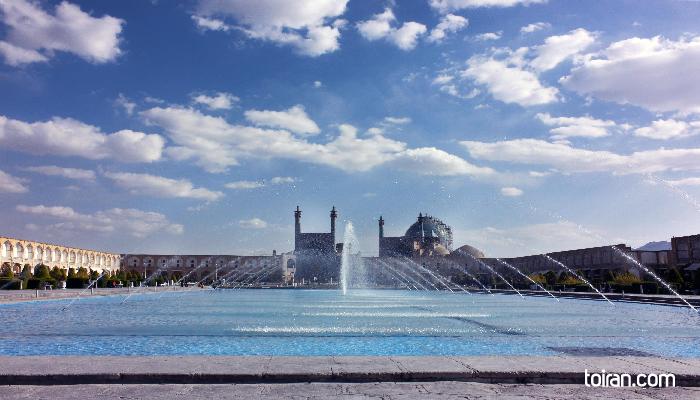Naqsh-e Jahan Square, the second largest square in the world after Tiananmen Square in Beijing, China, is a masterpiece of Islamic and Iranian architecture, which sits at the heart of Isfahan city in an area of 89,600 square meters.
This royal square, which literally means ‘Exemplar of the World,’ was designed by the polymath Sheikh Baha’i (1547- 1621) upon the order of the founder of the Safavid Dynasty, Shah Abbas I (1571-1629).
The square is surrounded by Isfahan Bazaar or Qeisarieh in the north, Sheikh Lutfollah Mosque in the east, Imam Mosque in the south and Ali Qapu Palace in the west.
The first of the four monuments dominating Naqsh-e Jahan Square is Sheikh Lutfollah Mosque which was built as the private mosque of the royal family and court over a period of 18 years. Unlike other mosques in Iran, Sheikh Lutfollah Mosque has no courtyard or minarets.
Despite its simple architecture, the finest materials were used in the construction of the mosque and prominent artists like calligrapher Ali Reza Abbasi were commissioned to create its complex interior and exterior decorations. This mosque has a famous underdome which has inspired the creation of beautiful Persian carpets and Iranian squares.
Imam (Shah) Mosque, also known as Jame Abbasi Mosque or Royal Mosque, was built to replace the Jame Mosque of Isfahan as the venue for the Friday Prayers. The dome of this mosque was designed by Sheikh Baha’i so that travelers on the Silk Road could see it glittering like a turquoise gem from miles away.
Ali Qapu (Imperial Gate) Palace is actually a six-story pavilion, which was the entrance to the Safavid royal quarters. Shah Abbas I spent most of his time in this palace, entertained visitors and foreign emissaries there and used the upper galleries to watch polo games, military parades and to host lavish banquets.
Isfahan Bazaar is one of the oldest and largest bazaars in the Middle East. This two-kilometer vaulted street connects the main entrance known as Qeisarieh with the city’s Jame Mosque. Above the portal of Qeisarieh Bazaar is a tribune that once accommodated musicians giving public concerts.
The magnificent multi-purpose Naqsh-e Jahan Square, which served as a marketplace, polo field, place for social meetings, concert grounds and a festival park, is depicted on the back of the Iranian 20,000 Rial banknote.
Naqsh-e Jahan Square has been designated by UNESCO as a World Heritage Site.








I think most of the foreign tourists coming to Iran beside Persepolis in Shiraz have this amazing place in mind. It is amazing, I spent a full day wandering in this historical wonder and i still feel i could go for more :)
Besides the historical and architecture wonders of the square are the traditional restaurants. Some of the best traditional plates in Iran are served here :)
My favorite place in Isfahan is the Naqshe Jahan Square, even if you have seen all the mosques and Ali Qapu Palace the square itself is worth visiting time and time again. Very few places in the world have the mixture of the traditional bazaar, two mesmerizing mosques, and a palace in a single square. The square itself comes to life with so many people both locals and visitors gathering in its vast green space outdoors and just enjoy the view.
It is the second biggest square in the world and you won't get tired of just hanging around it. beautiful place